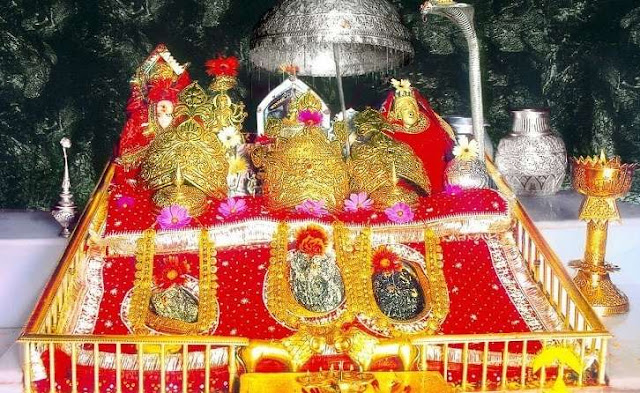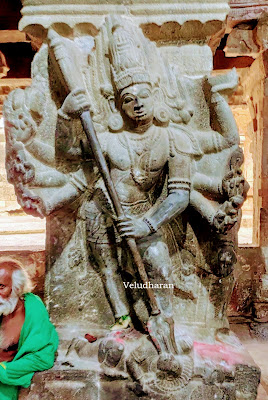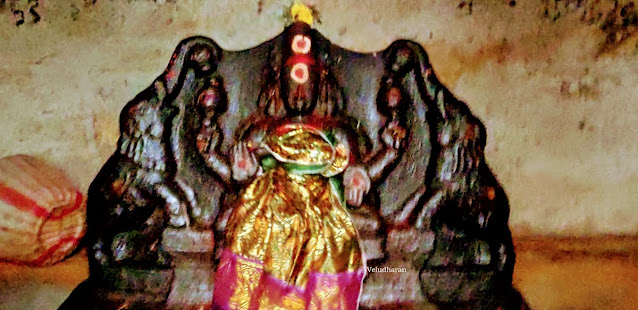The visit to this Kokarneswarar Pandyas Rock Cut Cave Temple at
Thirukokarnam near Pudukottai was a part of structural and Rock Cut cave Shiva and Vishnu temples visit in
Tiruchirappalli, Pudukottai and Sivagangai Districts, on 21st
November 2021. This temple is popularly known as Brahadambal temple.
Moolavar : Sri
Kokarneswarar
Consort : Sri Brahadambal
/ Araikasu Amman
Some
of the salient features of this temple are….
The
temple is facing east with an entrance arch. Stucco image of Vinayagar, Lord
Shiva with Parvati as Rishabarooder and Murugan are on the top of the front
mandapam. A stucco image of Shiva Linga is on the back of Rishaba Rooder. A 5
tier Rajagopuram is after the front mandapam. Moolavar is carved out of mother
rock and Avudayar is square in shape. Since this is a Rock cut cave, Koshta
Deities are installed in the praharam. Balipeedam, Dwajasthambam and Rishabam /
idabam are in front of the ardha mandapam. Dwarapalakas are at the entrance of
ardha mandapam.
In praharam and mandapam, Vinayagar, Adhikara nandhi with his
consort, Dwarapalakas on a platform, 63 Nayanmars, Lord Shiva and Parvati as
Rishaba roodar, Brahma, Gaja lakshmi, Jwarahareswarar, Suryan, Chandran,
Nalvar, Sahasra ( 1008 ) Lingam, Subramaniyar with Valli Devasena, Annapoorani,
Durgai, Mahalakshmi, Mangala Nayagi, Magizh Vaneswarar, Vinayagar, Brahadambal /
Araikasu Amman and Chandikeswarar. All Parivara deities are installed in
different levels, depends on the elevation of Rock.
Kali & Oorthuva Thandavar
Manmathan & Rathi
Nandi & His consort
Vinayagars
Saptamatrikas
ARCHITECTURE
Mandapams…. After the entrance arch, the mandapam was built
during Vijayanagara Nayaks period with exhaustively carved pillars. After
Dwarapalakas on a pedestal the second path ends at the 3red entrance. On the
Left is the Utsava mandapam. The Mandap pillars has the sculptures of
Oorthuva Thandavar with Nandi playing mridangam and Brahma playing thalam. A
male is sitting on a female and playing Veena. Kali’s dance sculpture is on the
opposite to oorthuva Thandavar.
Vinayagar, Murugan, Lord Shiva, Saraswati, Mahishasuramardini, Rathi and
manmathan are on the pillars.
Ambal Brahadambal is in a separate sannidhi facing east.
Dwarapalakis are at the entrance of sanctum sanctorum. Ambal is in standing
posture on a lotus pedestal with 4 hands. The upper hands are holding lotus
flower and lower hands are in abhaya & Varada hastam. Ambal is in
jadamagudam, wearing makara kundalam.
There are two sets of saptamatrikas in this temple. One set
is on a pedestal cared out of individual
slab stones along with Vinayagars. 6 Vinayagars are installed in L shape in
continuation to the saptamatrikas. The other set of Saptamatrikas are carved on
the rock with Veerabhadra and Vinayagar. Veerabhadra is 4 hands without any
weapons. Each one are sculptured with differences in dress, ornament etc.
Mostly they wears Jada Magudam, Poottu kundalams, Kandigai, shoulder &
bangles. Yagnopaveetha is in the form of Niveetham. In this Group Brahmi is
only with 4 hands and rest of the matrikas are with 2 hands. All Saptamatrikas
are wearing ornaments and yagnopaveetham. Maheswari I without marbukachchai /
brazier. Chamundi is keeping her right leg down, holding a small sword. She
wears padhra kundalam, bretha kundalam, Jwalamudi, chavadi in the neck and
without marbu kachchai / brazier.
The rock cut sanctum Sanctorum is with two square pillars and two pilasters.
The cave is 4.97 meters long and 51 cm wide. The pillars are, square with
tharanga pothyal. After Utharam Vajanam and ceiling is excavated. The
projection is about 44 cm forms kapotham in half moon shape. The sanctum
sanctorum is measuring east- West 3.16
meters, North – South 3.23 meters and height 2.17 meters. The avudayar is of
square with upanam. Jagathi, kumudam and kampu – Kandam, pattigai top Kampu.
Shiva Linga is about 69 CM tall. The komukha is on the north side. A stucco
Vesara Vimana is constructed on the rock just above the sanctum sanctorum.
First level and greevam has the images of Dakshinamurthy, Maha Vishnu as Narasimha and Brahma. Vinayagar is on the left facing north and Gangadharar is on the
right wall facing south.
Vinayagar … The Vinayagar is of 1.92 meters in sitting
posture. Mothagam is on the right hand, Thantham and wearing karanda magudam,
cloth yagnopaveetha, sarappalli, Utharabandham, Araipattigai, Silk cloth dress,
Gangadharar… Only 4 Gangadharar sculpture are available in rock
cut caves in Tamil Nadu. This is one of them. Gangadharar is about 1.98 meters
high. He is in standing posture, keeping left foot firm on the ground, folding
right leg up to knee. Wearing a maravuri below the hip. Lower right hand is in
kadi hastam, left hand is in kadivalampiththam. Wearing Neevitha yagnopaveetha,
kandigai, charappalli, makara kundalam in ears and Jada Magudam. Ganga is on one
of the strand, in kneeled position with anjali hastam. Ganga is wearing padre
kundala, Chavadi in neck, Thanda in legs, half dress below hip and marbu kachu,
looks beautiful.
Makizh Vaneswarar & Mangala Nayagi….. Makizh Vaneswarar shrine is with
sanctum sanctorum, mukha mandapam. A Two tier dravida vimana is on a padabandha adhisthana. The salaipathi is protruding out and Kuda panjaras differentiates
the salaipathi. Pattigai is in the form of kapotha. Dakshinamurthy, Lingothbavar and Brahma are
in Vimana koshtam. Chandikeshwara is on the north side.
Mangala Nayagi… The sanctum Sanctorum mandapam pillars has
the sculptures of Warriors, Lord Shiva as Oorthuva thandavar, Kali, Devotees.
An Ekathala vimana is over the sanctum sanctorum adhistanam. The adhistanam is
of simple padabandha adhistanam. Brahmakantha pilasters supports the wall /
bhitti. The pothyals are vettu & tharanga pothyals. In sanctum sanctorum, Ambal Mangala Nayagi is
in samabhanga standing posture. Ambal is
with 4 hands holding Nilotpala flowers in the upper hands and lower hands are
in abhaya varada hastam.
HISTORY AND INSCRIPTIONS
With the presence of Pallava grantham and Pandya King
Maransadayan alias Varagunavarman’s inscriptions, this rock Cut Cave may
belongs to 07th to 8th Century. About 25 inscriptions are
recorded from this temple, and still some are to be recorded. The earliest
inscription starts with Pallava Grantham as “Sthabanachcharyo
baagaththaachcharyaha..”, which belongs to 7th to 8th
Century, may be Pandya period. As per earliest Varaguna Pandya’s and
Parantaka-I ‘s period inscriptions Kokarnam is in Vallanattu Thiruvelpur
Kokarnam. The Rajakesari, Parakesari
inscriptions, which belongs to Rajaraja-I, records this place as Thenkavira
nattu Thiruvetpur Kokarnam. Vijayanagara period inscriptions records this place
as Thenkavira Nattu Jayasinga Kulakala valanattu Kokarnam. This place was
mentioned in Kulothunga Chozha –III’s inscription at Thiruvetpur.
About 12 inscriptions recorded belongs to Chozha period. Out
of 12 inscriptions one belongs to Rajaraja Chozha-I’s 12th reign
year. Rajendra Chozha-I’s 24th reign year inscription records his
titles, which is incomplete. Kulothunga Chozha-I’s 12th reign year
inscription is in the form of a poem. Kulothunga Chozha-II’s inscription
records the erection of Kalingu.
Rajaraja Chozha-III’s 20th reign year inscription records the
rule of Hoysalas in Chozha Country.
In Pandya period inscriptions belongs to Maravarman Veerapandian, Maravarman Kulasekara Pandyan and Sundara Pandyan.
Vijayanagara period inscriptions belongs to Saayana Udayar,
Viruppanna Udayar and Pradhaabadevarayar
Thiruvetpur inscriptions records the gift of Thiruvetpur and
Kokarnam to this temple as Devathanam. The inscriptions also mentions the
Thenkavira nadu, Pampur Nadu, Valla Nadu, Thiruvazhunthur Nadu, Thenpannkattu
Nadu. The inscriptions also mentions 18 Village names
Kulothunga Chozha-II’s inscription records the erection of
“Rajarajan Kalingu”, by Irumbazhi maRavan Arasan Devan alias Anabhaya
natalzhvan .
Nattars… Thiruvetpur Arayar received land as sale agreed to
supply paddy and money to Selva Kooththar ( Natarajar ). In this the signatures
of Jayangonda Chozha Pallavarayan, Chembian Konar, Chembian Velar, Uthama
Konar, Azhagiya Chozha Velar, Vallathu VenRRaar, Jayathunga Pallavatharayar,
Arayan UdanpiRappazhagiyar, Vallanattu Velar, Chembiyan Pallavatharayar, Villavarayar and Kadavatharayar alias
Thenkaviranattu Nattars.
Kavirakulam was a big irrigation tank and water was taken to
the fields through channels / vaikal, Perungumizhi and Sirukumizhi. For the
same Kanjai Nambipiran Kiramavithan of MeRkillimangalam Village donated a land
as Kulapatti.
Sayana Udayar period inscription records the sale of a paddy
field to this Lord Kokarneswarar. In this the document also signed by the
nattars. One of his inscription records
that due to the lack of maintenance of Kulam / eri was dried and the fields
were also dried without water. Tax exemption was given to these lands.
Maravaarman Vira Pandyan period inscription records the collection
responsibility of Taxes 60 panam per year called Vadakadamai was given to the
Nattars. Some of the taxes mentioned in the inscriptions are Kadamai,
Vettipattam, Panchipeeli, Santhuvikrakapperu, etc,.
Parantaka-I’s 3rd reign year inscription records
the endowment of burning a lamp during Siru kalai sandhi / early morning pooja
/ service to Thirukokarna Nattu Mahadeva in Thenkavira Nadu by Sama Nayakan Kudaiampataran of Veera
Chozhapuram for the same one kalanju gold was gifted. This was received by
Bhaarathaayan Kadan Bhujangan, Saththam arampallavan, Saththam Bhjangan,
Mazhapadi Nichal.
Koparakesari’s 4th reign year inscription
records a gift of 15 Kalanju gold for
burning a perpetual lamp in the temple of Kokarnanattu Mahadeva at Thiruvelpur
in Kavira nadu (?)a sub-division of Valla nadu. The donor’s name is not clear
seems to have been a resident of Sirukulattur and the same was received by
Thali Upasakar. .
Pandya Period inscriptions also records the governance of the
temple was entrusted to the Donors. The right of cultivation was given to the
Lands gifted to the temple and a portion of the yield was given to this temple.
Rajaraja Chozha –I’s 10th reign year inscription
records that Hoysala king Veerasomeswaran’s mother Somaladevi’s small child Vachchiyan, for the wellness of
his mother Manjavi and father Parusadevar established an endowment to continue
the perpetual lamp. Also from Uttarayana first day lighting of additional
perpetual lamp, for the same land was gifted. In the land gifted a nandavanam
was established to yield 2 nazhi flower. This was received by Siva Brahmins.
Rajaraja Chozha-I’s 13th reign year inscription
records that the lands belong to Madevar
at Sri Kokarnam made tax free by the nattars, who received a lump sum of 20
Kasu and an annual interest / grant of 5 kasu from Adambaramudaiyan Velaan
kaari of Pambur Nadu.
During the draught, a situation arised that the temple
authorities found difficult to arrange for offering to God, Kavira Nattars
gifted a field land. The land was
received as sale by Thiruvetpur Arayar Periya Velar agreed to supply 3 kalam
paddy during mathal pasanam ( irrigation ), during summer ½ of the 3 kalam and punjai land 3 panam to this Selva Kooththar.
Maravarman Sundara Pandyan period inscription records the
endowment of “Pallavan Sandhi”, a special prayer by Pallavarayar and for the
same a land was sold to him by Kavira Nattars and Arayars. Also to celebrate
Vaikasi Thiruvizha and theerthavari to Lord Shiva. The same way Pallavan
sandhi, Pallavan Thirunal was established on Avani month Chithirai
theertham to this temple’s Lord Shiva
and another Utsavar.
To get Tax emption for the land owned by Velaankaari gave 20
Kalanju gold to the Nattars. The Nattars agreed to remove tax for the interest
earned to the 20 Kalanju Gold. This interest was utilized for naivedyam during
3 kala poojas and offer during thirubali. ( To be verified )
Sri Koparakesari’s 13th reign year inscription
records some provision has been made by a resident of Thiruvetpur for the
celebration of a festival on asterism Uttaram in Panguni Month to God Ganapati
in the temple at Sri Kokarnam In Kavira Nadu.
On that day naivedyam was sponsored by Emperuman for the same
one thulai pon / gold was gifted to this temple. From the interest of 3 kalanju
gold naivedyam was offered.
Thiruvetpur Velar Venkadan established an endowment of
celebrating Panguni Thirunal / Brahmotsavam for 7 days for the same 9 kasu was
gifted to temple upasakar. As an interest 4 Nazhi thoonipathakku paddy was supplied
to this temple. For this naivedyam was offered on all the 7 days to the
Utsavars of Lord Shiva and Ambal.
Arasu Vizhithurangum Perumal Pallavarayar established an
endowment of pooja and maintenance for
the same paddy field was gifted to this temple.
Veerapandiya period inscription records that the construction
of Vimanam for Thirubhoomiswaram udaya Nayanar for the wellness of
Semapillayar. He is the King’s one of the agambadi Mudalis. Brahadambal
Sannidhi mandapam was constructed by Pallavaraya Manickaththal Ethiyar. The
SiRpamandapa was constructed by Raya thondaiman ( 1686 – 1730 CE ). The Kulothunga Chozha – I’s 12th
reign year poem inscription praises a person / Annal of Thondai Nadu for
increasing the wealth through Thenkavira Kulam / eri, sluice and the channels for irrigation in
Thenkaviranadu. The inscription also records the gold plating of Perambalam by
Kulothunga Chozha-I.
Maha Kumbhabhishekam was performed on 23rd June
1982 and 23th March 2005.
LEGENDS
The Thondaiman Kings used to worship Brahadambal as their Kula Deivam. It is believed that Ambal spoke to Thondaiman Kings face to face.
As per the legend, the divine cow Kamadhenu was cursed to
become an ordinary Cow by Devendra / Indra. As per the advise of Kapila and Manga
Maharishi, kamadhenu came to earth and worshiped Lord Shiva with Ganga water. One day while it was
carrying Ganga water, Lord Shiva in the form of Tiger came and threatened
Kamadhenu to eat her. Kamadhenu requested tiger to allow her to do pooja to
Lord Shiva and then he can eat. After completing the Pooja Kamadhenu went to
the tiger to eat her. Lord Shiva appeared before her and blessed with all her
original powers.
Devotees worships Lord Shiva and Brahadambal / Araikasu Amman
to get back the lost materials, to remove marriage obstacles, Child boon etc.
POOJAS AND CELEBRATIONS
Apart from regular poojas special poojas are conducted on
Pradosham, Maha Shivaratri, Vinayagar Chaturthi, Panguni Uthiram, Vaikasi
Visakam, Deepavali, Tamil and English New Year Days, Thai Pongal, Thaipoosam,
Arudra Darshan, Karthigai deepam, etc.
TEMPLE TIMINGS
The temple will be kept opened between 07.00 hrs to 12.00 hrs
and 16.00 hrs to 20.00 hrs.
CONTACT DETAILS
The land line and the mobile numbers, +91 4322 221084 and +91
94861 85259 may be contacted for further details.
HOW TO REACH
The
temple at Thirukokarnam is about 3.1 KM
from Pudukkottai bus Stand, 3.7 KM from Pudukkottai Railway station, 50 KM from
Trichy / Tiruchirappalli, 60 KM from Thanjavur 376 KM from Chennai.
Nearest
railway station is Pudukkottai and Junction is Tiruchirappalli.
Rishbaroodar
Dakshan, Maha Vishnu in Koorma avatar & Saraswati
Nalvar & chandran
Dwarapalakas
Lord Shiva in rock Cut Cave
---OM
SHIVAYA NAMA---





































































